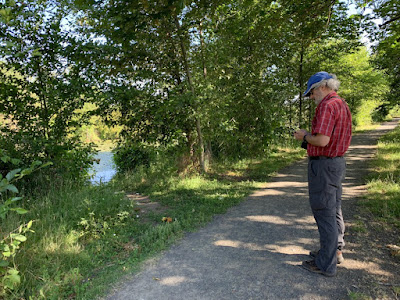52 Places to Go: Week 39
 |
| Legion of Honor Art Museum, San Francisco, CA, modeled after the Palais de Legion de Honneur, Paris, France |
The classical elegance of the Legion of Honor art museum in San Francisco sits high above the Pacific, offering a spectacular view of the Golden Gate headlands. (On the day we visited the coast was shrouded in fog, but the setting was still inspiring.) The huge permanent collection inside the museum focuses on ancient and European art, works on paper, and more, displayed in large, airy, elegant rooms.
 |
| Entrance to Last Supper in Pompeii exhibit. |
In early May, my daughter and I and a friend did an excursion to the Legion of Honor to view two special exhibits--The Last Supper in Pompeii, focusing on food and drink as seen in frescoes, mosaics, artifacts and even a carbonized loaf of bread from the ruins of Pompeii; and I am Speaking, Are You Listening?, the sculptures and paintings of artist Wangechi Mutu, intriguingly placed in conjunction with Rodin sculptures and other traditional art of the museum’s permanent collection.
 |
| Rodin sculpture; sculpture and paintings by Wangechi Mutu. |
The Pompeii exhibit is now closed but the Wangechi Mutu exhibit will be up until November 7, 2021. For an interview with Wangechi Mutu, click HERE. We also did a quick tour of the permanent collection, including a room full of Impressionist art. It was a great choice for my first public outing since the beginning of the pandemic. Timed entry tickets, masks and social distancing made us feel safe and allowed plenty of room to see the art both up close and at a distance. Tables in the museum cafe, where we had a delicious lunch, are also spaced apart.
We began our visit with the Pompeii exhibit on the ground floor of the museum. Each item was accompanied by a label with sometimes surprising explanatory information. A fresco depicting what looked like a baker at his bread stall in the market was revealed to be a Roman politician handing out free loaves of bread as he appealed for votes.
 |
| Mosaic of sea creatures |
Among my favorite items was a depiction of edible fish in a panel made of tiny mosaic tiles, “drawn” in such detail that they almost looked painted. I especially liked the octopus, having just seen the movie “My Octopus Teacher” an ode to the intelligence of this adaptable cephalopod.
 |
| Sculpture by Wangechi Mutu |
Our first encounter with the Wangechi Mutu exhibit was in the museum's outer courtyard where we found large half-human/half-reptile figures flanking Rodin's Thinker. Inside the museum we found more of Wangechi Mutu's art installed side-by-side with the permanent exhibits in several of the galleries. (I had not previously appreciated the extent of the museum's Rodin collection that filled several rooms.) Using natural materials (mud, sticks, shells, stones) Wangechi Mutu's pieces seem to grow out of the earth.
 |
| At the back of the room, behind Wangechi Mutu's figure, we see Rodin's Shades from the Gates of Hell. |
Wangechi Mutu: An artist who calls both Nairobi and New York home, she moves voraciously between cultural traditions to challenge colonialist, racist, and sexist worldviews with her visionary projection of an alternate universe informed by Afrofuturism, post-humanism, and feminism. Mutu’s sprawling exhibition at the Legion of Honor, a museum built for the showcase of European art from antiquity through Impressionism presided over by Auguste Rodin's The Thinker, aims to spur “a purposeful examination of art histories, mythologies, and the techniques of archiving and remembering.” (from the museum website)
 |
| I am speaking. Are you listening? |
The signature piece of the exhibit is a pair of figures facing one another, as if in conversation, I am speaking. Are you listening? At the same time, the artist is in conversation with us, the viewers.
In this exhibit, while the contrast between old and new, traditional and experimental, is sometimes disconcerting, it makes us look at both with refreshed eyes. I didn't plan on seeing the Wangechi Mutu exhibit when i bought my Pompeii tickets, but I'm glad I did.


















